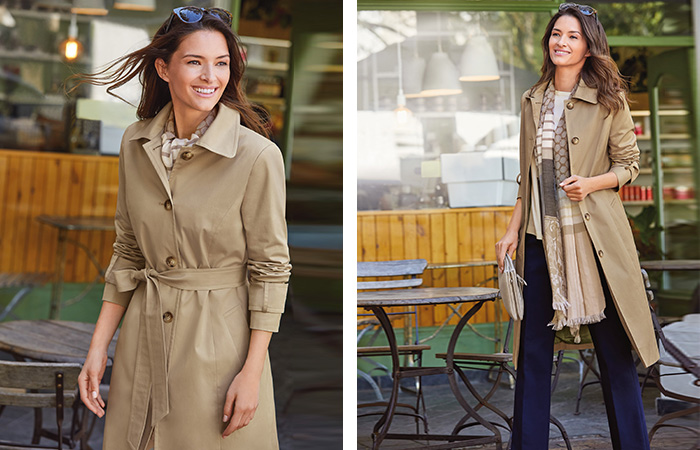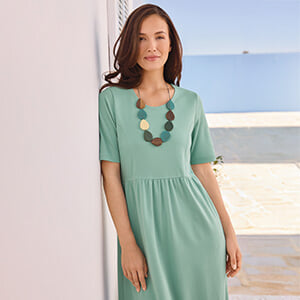Is there a better item that defines a versatile wardrobe staple than the trench coat? A timeless perennial classic, it can tie any look together to form a chic, stylish outfit and there has never been a better moment to own one or update yours.
Take a look at the beautiful new addition for Cotswold Collections New Season >>

The trench coat, so named because of the myth that its existence originated during the First World War actually first dates back to the 1820’s. It was born from the collaboration of Scottish chemist and inventor Charles Macintosh and British inventor Thomas Hancock (who was also the founder of the British rubber industry) and their drive to invent a waterproof coat.
The first rain repellent version was nicknamed the “mack” after Charles Macintosh and the nickname is still widely used today, even being coined for the non-Macintosh versions of the coat. Charles Macintosh and Thomas Hancock had the vision that the coat would be worn by well-dressed military men who, in their spare time would spend their days riding, shooting and fishing. As technology evolved, so did the fabric and design of the trench coat, offering more breathability and better protection against the elements.
 Portraits of Charles Macintosh and Thomas Hancock.
Portraits of Charles Macintosh and Thomas Hancock.
Nearly 30 years later, in 1853 the model of the modern trench coat was developed by a Mayfair gentleman’s tailor, John Emary. Under his company Aquascutum (meaning ‘water’ and ‘shield’ in Latin) he developed a newer and improved raincoat. Thomas Burberry, a young draper at the time emulated Emary’s achievement and created his well-known eponymous brand. By 1879 Burberry had invented an innovative fabric ‘gabardine’, where each individual strand of the cotton and wool fibre was weatherproofed rather than the finished garment. This made the finished piece the most breathable and enduring yet and became vastly popular with adventurers and aviators alike.
Both Aquascutum and Burberry claim for having “invented” the World War I trench coat, but the two companies actually aided in the popularisation of a coat that already existed but adapted it for its military use. Key identifiers between the WWI trench coat and original ‘mack’ are the waist tailoring, double-breasted front and below-the-knee flared hemline. Other elements of the new design included a cape back to allow water to drip off, the storm flap at the shoulder provided ventilation while the buttons at the neck helped protect the wearer from poison gas.

During the Great War, it was primarily those of officer ranking and above who were able to purchase the coat as part of their uniform and it became symbolic of the class separation. The coats were issued in khaki to provide the best camouflage and the rank of the wearer would be notable from the epaulettes on the shoulders. Soon, acts of valiant, brave and heroic behaviour were associated with the garment and foreign soldiers and civilians began wearing the coat, buying into its patriotic connotations.

Again, the coat assisted soldiers during the Second World War with the woollen khaki or brown versions being worn by the allies, while the axis opted for grey or black leather alternatives. However, the romanticism of the 1940’s and 1950’s Hollywood era soon began eradicating the trench coat of its the military connotations. The golden film era replaced the image of the upper-class officer with the alluring femme fatale, dashing spy, detectives and gangsters.
The silver screen made the trench coat an even more covetable item and embodied it as a timeless fashion staple through being worn in some of the most iconic scenes in history by film and fashion royalty such as Humphrey Bogart in Casablanca, Audrey Hepburn in Breakfast at Tiffany’s and Marilyn Monroe in Let’s Make Love.


Today the trench coat whether a Mack, Burberry or variation of, still carries the powerful, effortlessly glamorous and functional style of its past. It arguably has become a fashion piece as important, iconic and equally as timeless as blue jeans. Certain features remain ever popular; the wide lapels, epaulettes, large pockets and belted waist. The lightweight fabric and weatherproof finish also remain a staple characteristic. It has been recreated, redesigned and fashioned in a plethora of colours by fashion houses all over the world and as exciting as its future is, the origins of the trench coat, and its importance to its original cause, should never be forgotten.
What do you love most about the trench coat? Is it one of your wardrobe staples? Let us know in the comments below...


